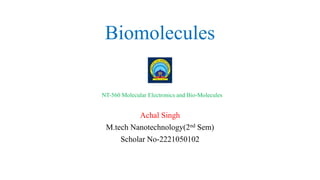
Biomolecules.pptx
- 1. Biomolecules Achal Singh M.tech Nanotechnology(2nd Sem) Scholar No-2221050102 NT-560 Molecular Electronics and Bio-Molecules
- 2. Contents Organic molecules Carbohydrates Monosaccharides Disaccharides Polysaccharides Lipids Fatty acids Phospholipids Proteins Nucleic acids DNA RNA Ref.-quizizz
- 3. Organic Molecules Formed by living things Form the base of all living beings Have a carbon backbone Ref.-buzzle
- 4. Carbohydrates General Formula-[CH2O]n Short-term energy storage- Sugars Intermediate energy storage Starch- Plants Glycogen-Animals Structural Components Cellulose-Plant Cell Wall Chitin- arthropods (insects) exoskeleton Carbohydrates Simple Monosaccharides Disaccharides Complex Polysaccharides
- 5. Monosaccharides Simplest form of sugars- cannot be further hydrolysed. Ribose- a pentose[5-C sugar] occurring in vitamins and enzymes. Glucose- The fastest and main source of energy.[6-C sugar] Hexose- a term for 6-carbon[C]sugars. Ref-fattoenergy Ref.-Visionlearning
- 6. Disaccharides Two monosaccharides chemically bonded together Sucrose [Glucose + Fructose] – The sugar we get from sugarcane Lactose [Glucose + Galactose] – Present in milk. Ref.-nutrientsreview Ref.-dreamstime
- 7. Polysaccharides • Macromolecules consisting of many monosaccharides bonded together. • Formation of ester bond-esterification. • Removal of water molecule by condensation. • Example- starch, cellulose. Ref.-Americanboard Cellulose Ref.-public.oml.gov
- 8. Polysaccharides(contd.) • Starch • A polymeric molecule made by many glucose[referred as glucans in polypeptide] molecules bonded by α-(1→4)-D glycosidic bonds. • Used by plants for energy storage. • Consist of 2 chains: • Amylose-straight chain • Amylopectin- branched chain oCellulose oFound in plant cell walls oIndigestible by humans oMade up of only β-glucose( opposed to α,β in starch and glycogen). Ref.-healthjade
- 9. Lipids Long term energy storage. Insoluble in polar solvents such as water. Secondary Functions Structural components-phospholipids in cell membranes Messengers-hormones: communication within and in-between cells Simple lipids are usually composed of 3-fatty acids covalently bonded to 3-C glycerol. Lipids are classified into: Saponifiable lipids- can be hydrolysed [triglycerides, phospholipids] Non-saponifiable lipids- cannot be further hydrolysed [cholesterols]
- 10. Fatty Acids oHydrocarbon chains terminating with carboxylic acid groups. oTypes o Unsaturated fatty acids- unsaturated C-C bond o Saturated fatty acids- saturated C-C bonds oFunctions: o Signal-transduction pathways o Biological signaling through series of molecular events. o Insulation and cushioning. o Cellular fuel sources o Energy storage in adipose tissues(fat-cells)-in form of triglycerols. o Composition of hormones and lipids o Protein modification Ref.-periodni.com
- 11. Phospholipids • Basic building structure of cell membrane • Consists of • 2 fatty acids tails- 2non-polar tails • 1 phosphate head- 1 polar head • Phospholipids in cell membrane are semi-permeable • Molecules dissolving in fat can pass easily. • Molecules dissolving in water cannot pass easily. Ref.-Lumenlearning
- 12. Proteins Complex biomolecules made up of many small units called amino acids. Amino acid is an organic molecule consists of a central carbon atom attached to An amino group, a carboxyl group, A hydrogen atom and, a variable side chain (R group) . The amino acids strands are twisted to form long chains. There are 20 amino acids common to most proteins. The specific order of these amino acids determines the structure and function of proteins. Ref.-thesupplestrength Ref.-openoregon
- 13. Nucleic acids • Polymers composed of monomer units known as nucleotides. • Main functions • information storage (DNA) • protein synthesis (RNA), • and energy transfers (ATP and NAD). • Nucleotides consist of • a sugar, • ribose or deoxyribose • a nitrogenous base, • Purines (Adenine and Guanine) - double-ring structures, • Pyrimidines (Cytosine, Thymine and Uracil)- single-ringed. • a phosphate. Ref.-ScienceNotes
- 14. Deoxyribonucleic acid (DNA) Physical carrier of inheritance for 99% of living organisms. 4 nitrogenous bases of DNA (C, G, A, and T) code for 20 amino acids found in all living things, make an infinite variety of polypeptides. A mutation is any change in the DNA base sequence causes evolution. Ref.-101diagrams
- 15. Ribonucleic acid (RNA) oDNA (except in chloroplasts and mitochondria), is restricted to the nucleus/nuclear region. oRNA occurs in the nucleus as well as in the cytoplasm (also as part of the ribosomes that line the rough endoplasmic reticulum). oThere are three types of RNA: o Messenger RNA (mRNA) is the blueprint for construction of a protein. o Ribosomal RNA (rRNA) is the construction site where the protein is made. o Transfer RNA (tRNA) is the truck delivering the proper amino acid to the site at the right time
- 16. References Biologydictionary.net Dr. Fozia Z. Haque, NT-550 Molecular Electronics and Biomolecules, Simple Molecules- Lecture plan.